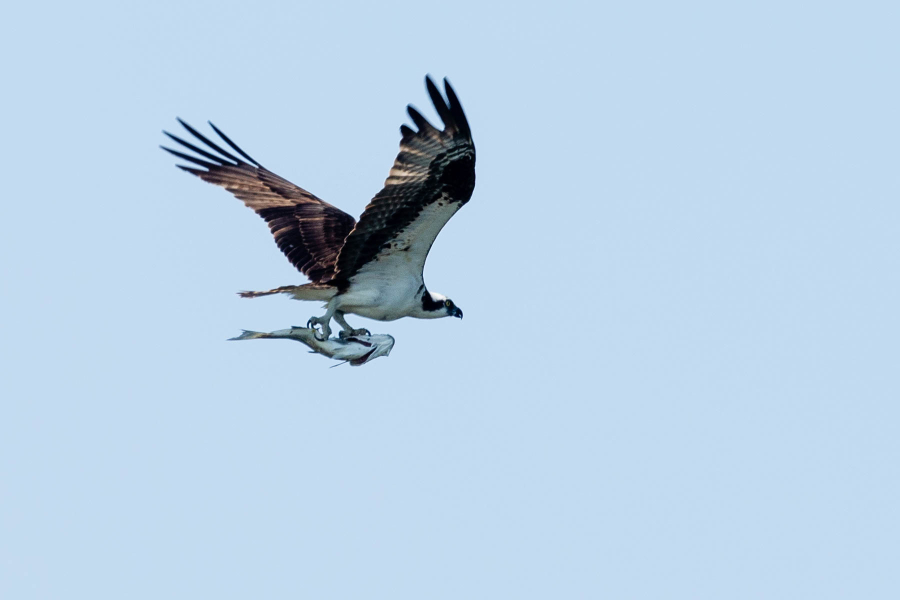The Bay’s fisheries are feeling the heat

You’d be hard-pressed to find a more iconic Chesapeake image than the above photo. The largest breeding populations of osprey in the entire world is found in the Chesapeake Bay. One reason why is due to the number of delectable fish that is available for it to feed on. One such species is the striped bass, otherwise known as the rockfish, which is featured here in this photo, about to become the osprey’s snack.
The Chesapeake’s food web finds itself consistently in a delicate balance, thanks to such threats as climate change and overfishing. Ospreys are dependent on striped bass and other large fish species, who in turn rely on forage fish, such as menhaden and herring, who receive sustenance from microorganisms in the Bay. If one link in this chain goes awry, our entire ecosystem is impacted.
The National Oceanic and Atmospheric Administration (NOAA) recently released their 2021 State of the Ecosystem: Mid-Atlantic report, which evaluates current risks to and trends in the Mid-Atlantic region’s fisheries. The report mainly focuses on an area of the Atlantic Ocean referred to as the Mid-Atlantic Bight, which stretches from Cape Hatteras, North Carolina to Martha’s Vineyard, Massachusetts, but also includes data and information from the Chesapeake Bay.
Fishery trends are determined by a series of social, ecological and economic indicators. On the ecological side, the indicators look at protected species, seafood production and the stability of the fisheries, among others.
This year’s report noted a continual decline in both commercial and recreational seafood production throughout the Mid-Atlantic region. For commercial producers, the decrease was felt most heavily in the benthos group. Benthos refers to organisms that are found on the bottom of the ocean, as well as the Bay, like clams and worms. Experts believe the decline is due to market-driven pressures and climate change causing species to relocate to new areas. For recreational anglers, it is unknown if their decline in production is due to changes in fishing behavior or in how the data is collected. In more positive news, the current diversity of marine species is remaining constant, across both juvenile and adult fish.
Another trend the report measures is that of social vulnerability, which recognizes the importance of community to the coastal towns that historically have relied on fishing for their livelihoods, and evaluates their ability to respond and adapt to change. NOAA evaluates social vulnerability by looking at such factors as environmental justice, the impact of regulations on the community, climate resilience, recreational and commercial fishing engagement and the strengthen of the region’s economy. The most recent report finds that the majority of fishing communities in the Mid-Atlantic have declined over time.
When it comes to evaluating the risks that fisheries face, fingers consistently point to climate change. From the microorganisms at the bottom of the food chain to the larger fish species that mammals—including humans—depend on, it is no longer just a theory that warming air and water temperatures are altering the lives of our marine species.
The report also discussed how some conditions in 2020 also impacted the Chesapeake Bay ecosystem and the species that live here. On the bottom of the food chain are phytoplankton—aquatic plants that provide food for other marine species when the ecosystem is in balance. Warming water temperatures are accelerating their growth and due to a mild winter in 2020, the phytoplankton grew earlier than anticipated—before the striped bass larvae hatched. This is one significant factor that may have contributed to the low population of juvenile striped bass observed here last year.
Fishery managers in both Maryland and Virginia made changes rooted in science to their striped bass regulations in response to the decline in the species. The spring fishing season in both states will begin about two weeks later than normal, and in Maryland, anglers will be prohibited from catching striped bass for two weeks at the end of July, due to the presence of high water temperatures and low oxygen levels, which stress out the fish caught in those conditions.
The mild winter of 2020 also lowered what is called the overwintering mortality of blue crabs. This is the number of blue crabs that die off in between the fall and spring, due to frigid water temperatures. While some may think that having active blue crabs all year is positive news, it will cause ripple effects across the Chesapeake region’s food chain.
Climate change may be the most significant threat to the Chesapeake fisheries, but it’s not the only one. NOAA fishery experts also caution about potential dangers associated with offshore wind development. Over the next decade, 20 offshore wind turbine projects will stretch over 1.7 million acres of the Northeast. Near the Chesapeake Bay, an area 27 miles off the coast of Virginia Beach, Virginia has been leased for a wind turbine project. NOAA notes that wind turbines can displace the habitat of fish and mammal species, altering feeding habits and potentially causing even more negative impacts with vessels.
Recognizing these threats and understanding fishery trends now, only serves to help managers determine the best methods to balance both the Mid-Atlantic’s and the Bay’s ecosystems for years to come. Conducting research to inform reports like the State of the Ecosystem are critical in learning more about the connections between fisheries and the habitats they rely on. While there may be fewer striped bass fishing days in the Bay this year, we can be reassured that enough will be around for the osprey.

Comments
There are no comments.
Thank you!
Your comment has been received. Before it can be published, the comment will be reviewed by our team to ensure it adheres with our rules of engagement.
Back to recent stories